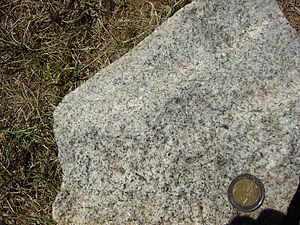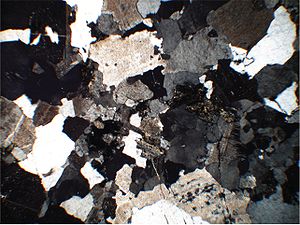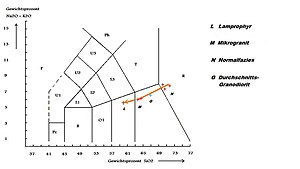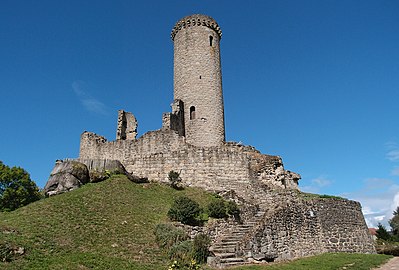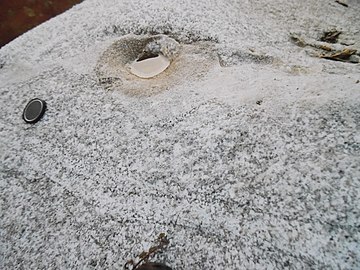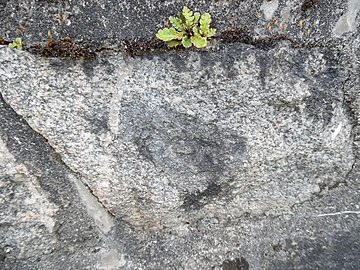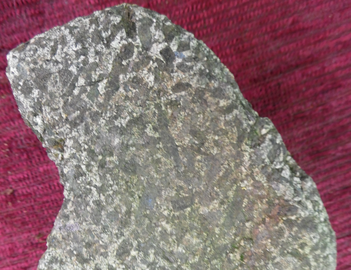Piégut-Pluviers-Granodiorite
The Piégut-Pluviers-Granodiorit is a granodiorite massif on the northwest edge of the Variscan Massif Central in southwest France . Its cooling age was dated 325 ± 14 million years BP ( Lower Carboniferous , more precisely Upper Mississippian , Serpukhovian ).
Geographical
The granodiorite massif is named after Piégut-Pluviers , a municipality in the north of the Nontron arrondissement in the Dordogne department , which lies in the middle of the massif. It has roughly the shape of an inverted comma with an almost square central part to the south, which is rotated in the southeast-northwest direction. This central part has a triangular extension tapering to the north. The central part measures a maximum of 15.5 kilometers in the northeast-southwest direction and 15 kilometers in the southeast-northwest direction. The extension is about 10 kilometers, but is separated from the actual massif by a very thin gneiss septum, about 100 meters thick (about 100 meters thick intermediate layer of migmatitic paragneiss). The granodiorite massif claims a surface area of around 250 square kilometers. Its lowest exposed point is at 135 meters on the western edge and its culmination point at around 375 meters above sea level in the northeast. It therefore represents a shed slab dipping slightly to the south-west , with only relatively minor differences in relief in its interior.
Geological overview
In the east, northeast and north the granodiorite massif (unit PPG on the geological map) is girdled by the Saint-Mathieu leukogranite and its equivalents (unit SML ), which is slightly younger with 315 ± 17 million years BP ( Pennsylvania , Bashkirian ). In the south-east and north-west, the massif delimits various paragneiss (unit P ). On its south and south-west side it is largely transgressed by sediments of the Lias , which belong to the Aquitaine Basin . Together with the Saint-Mathieu-Leukogranit, the massif forms a parautochthonous structural bulge in the basement, the so-called Cathedral of Saint-Mathieu .
The granodiorite often shows no sharp contact with the paragneiss, rather there is a diffuse transition area that can stretch over several hundred meters and in which granodiorite and gneiss layers repeatedly interlock. This suggests that the paragneiss are the parent rocks or host rocks of the granodiorite.
Structurally, the following structure can be seen in this section of the western Massif Central (from hanging wall to lying ):
- Upper gneiss cover ( UGU unit )
- Lower gneiss cover ( LGU unit )
- Parautochthonous mica slate with leuco granite (unit PMU )
- Granodiorite
- Paragneiss
General Introduction
The tectonomic development of the Massif Central can be divided into four sections. After an initial, eovarisian subduction on the northern edge of Gondwana in the course of the Silurian Mountains (430 to 400 million years), high pressure conditions arose (2 gigapascals and 700 ° C), documented by metamorphosed eclogite remains of an oceanic crust. The following mesovarican continental collision in the period 400 to 340 million years led to ceiling stacking and was accompanied by a regional metamorphosis of the Barrow type, with anatectic melts occurring for the first time in the Limousin . In general, the anatectic melt formations themselves can be divided into two types - the magmatites of the calcareous Limousin tonalite line from 370 million years and the peraluminous magmatites of the Guéret type from 359 million years . The latter appear as gigantic laccolites and are mainly made up of cordierite - and occasionally hornblende - containing biotite granites. The Piégut-Pluviers-Granodiorit is considered to be a later representative of this type.
During the subsequent Neo-Varisian development, the Variscan orogen was severed by numerous transpressive lateral shifts in the period 340 to 310 million years , which led to the formation of peraluminous two-mica granites ( leukogranites such as the Saint-Mathieu leukogranite) of the Limousin type . In the post-orogenic late stage between 320 and 280 million years, the orogen stretched and dome-like bulges of migmatite (for example the huge Velay dome in the east of the Massif Central) and infiltration basins were formed, which were filled with carbonaceous sediments. Recent magmatic developments in the Limousin were limited to very small, extremely specialized granite intrusions ( English Rare Metal Granites ), which were usually bound to faults.
Facies
The granodiorite massif is not homogeneous, but has several petrofacies . Including:
- Coarse-grained facies
- Coarse-grained porphyry facies
- Fine-grain facies
- Fine-grained facies with hornblende
Coarse-grained facies
The coarse-grained facies take up most of the granodiorite massif. The grain size is generally between 2 and 6 millimeters, with the individual grains being roughly the same size (isometric). When fresh, the rock is gray in color. It contains the following minerals:
- Quartz - round grains 1 to 3 millimeters in size, also agglomerations of 1 to 3 centimeters - 26 percent by volume
- Orthoclase - perthitic , Carlsbad twins, corroded by quartz, isolated idiomorphic crystals in the centimeter range - 18 percent by volume
- Plagioclase - often zoned, core andesine with An 33-35 , rim oligoclase with An 25 , isolated idiomorphic crystals in the centimeter range - 42 percent by volume
- Biotite - 1 millimeter in size, bronze-colored, with zirconium inclusions and often chloritized - 10 percent by volume
Accessories are zoned allanite , epidote , apatite , and occasionally green hornblende , zircon and zoisite . Pyrite acts as an opaque mineral . This facies occasionally contains dark, fine-grained, centimeter to decimeter-sized, rounded dioritic inclusions. The feldspar longitudinal axes often show adjustment.
The coarse-grained granodiorite facies are quartz normative ( oversaturated with SiO 2 ) and also corundum normative , they therefore have a peraluminous character. It is also sub-alkaline . In the granitoid typology, this is a calcareous rock of the I-type, which belongs to the K-series. Compared to average granodiorites, this type of rock has an increased SiO 2 content and approaches the composition of Monzonitic granites .
Coarse-grained porphyroid facies
This type of facies differs mineralogically and chemically only insignificantly from the coarse-grained facies, but it forms much larger feldspars (grain size usually between 1 and 4, sometimes even up to 6 centimeters). The grain size of the basic mass minerals is on average 5 millimeters, so it is also slightly larger than the normal facies. The transitions to the normal facies are fluid. Main areas of distribution are Lacaujamet near Piégut (former quarry for facade, window and door stones ) and Puybégout near Augignac .
Fine-grain facies
The fine-grained facies are mainly found on the southern edge of the granodiorite massif on the Bandiat near Nontron. Here, too, the transitions to normal facies are fluid - there is a gradual reduction in grain sizes. Mineralogy and chemical composition are also very similar, the only difference being a slightly more pronounced occurrence of hornblende and a lower content of alkali feldspar. Further occurrences of the fine-grain facies are located in a thin band on the northeast and northwest edges of the massif as well as in smaller isolated areas in the interior. The latter are likely to have arisen relatively close to the roof area.
Fine-grained facies with hornblende
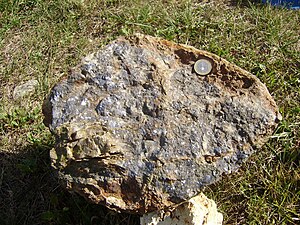
This is a fine to medium-grained rock with a dark color, which contains hardly any more alkali feldspar (less than 10 percent by volume), but is quite rich in green hornblende. It has a significantly lower SiO 2 content and its composition approaches dioritic rocks. This facies was previously quarried in the Tabataud quarry in the Bandiattal south of Nontron as building blocks and gravel. Associated with it are southeast-northwest trending veins that have been prospected for lead , silver and zinc . However, dismantling was stopped in 1939. The Cantonnier Gang has become known for rare and very rare minerals. In addition to barite , galena , calcite , chalcedony , dolomite , marcasite , pyrite and sphalerite , for example, angelsite , cerussite , dundasite , embreyite , hisingerite , crocoite , leadhillite , mimetesite , ozokerite , pyromorphite , solid silver, vauquelinite and wulfenite can be found .
In the immediate vicinity of the Cantonnier corridor, the fine-grained hornblende facies even appear as a massive, layered hornblendite with centimeter-sized hornblende crystals.
The following chemical compositions are mean values from 14 analyzes for the coarse-grained facies, 2 analyzes for the porphyry facies, 3 analyzes for the fine-grained facies and 3 analyzes for the fine-grained hornblende-bearing facies:
| Oxide wt.% |
Normal facies | Porphyry facies | Fine-grain facies | Delicatessen Hbl facies | CIPW norm percent |
Normal facies | Porphyry facies | Fine-grain facies | Delicatessen Hbl facies |
|---|---|---|---|---|---|---|---|---|---|
| SiO 2 | 70.49 | 69.98 | 71.83 | 64.43 | Q | 28.78 | 25.84 | 31.04 | 21.55 |
| TiO 2 | 0.44 | 0.42 | 0.30 | 0.61 | Or | 22.45 | 24.34 | 24.58 | 16.54 |
| Al 2 O 3 | 14.69 | 15.42 | 14.95 | 15.90 | From | 29.77 | 31.55 | 29.94 | 27.91 |
| Fe 2 O 3 | 0.93 | 0.51 | 0.43 | 0.82 | On | 9.69 | 9.31 | 5.44 | 17.08 |
| FeO | 1.38 | 1.65 | 1.48 | 3.42 | C. | 1.23 | 1.41 | 2.62 | 1.17 |
| MnO | 0.06 | 0.04 | 0.04 | 0.08 | Hy | 4.56 | 4.91 | 3.66 | 10.33 |
| MgO | 1.18 | 1.21 | 0.74 | 2.49 | Mt | 1.68 | 0.78 | 0.69 | 1.54 |
| CaO | 2.02 | 1.89 | 1.32 | 3.60 | Il | 0.83 | 0.82 | 0.56 | 1.15 |
| Na 2 O | 3.52 | 3.73 | 3.54 | 3.30 | Ap | 0.11 | 0.02 | 0.39 | 0.27 |
| K 2 O | 3.80 | 4.12 | 4.16 | 2.80 | |||||
| P 2 O 5 | 0.05 | 0.01 | 0.17 | 0.12 | |||||
| H 2 O - | 0.08 | 0.12 | 0.09 | ||||||
| H 2 O + | 0.90 | 0.86 | 0.87 | 1.78 | |||||
| Mg # | 0.59 | 0.56 | 0.47 | 0.55 | |||||
| A '/ F | 0.34 | 0.31 | 0.62 | 0.12 | |||||
| Al / K + Na + Ca | 1.08 | 1.10 | 1.17 | 1.05 |
The magnesium numbers Mg # range between 0.55 and 0.59, they are slightly higher than an average granodiorite. An exception is the very anomalous, fine-grained marginal facies with a very low value of 0.47. The aluminosity spreads rather strongly with a tendency towards pereraluminosity. The type of the Piégut-Pluviers-Granodiorite cannot be clearly defined, it is a borderline case of an intrusive I-type . Here, too, the fine-grained marginal facies show strong deviations towards an S-type , which was obviously contaminated by the metasedimentary paragneiss.
Micro-granite massif
The satellite microgranite massif in the north of the granodiorite massif is only separated by a very thin paragneiss septum in the Trieux valley . Genetically, however, it should be directly related to the main massif. It is a porphyry with a microscopically fine matrix. Two facies can be distinguished, one facies with a light gray base and one edge facies with a very dark base. In terms of mineralogical structure and chemical composition, the rock is very similar to the fine-grained facies of the main massif that contain hornblende. The phenocrystals can reach up to 12 millimeters and consist of quartz, plagioclase and biotite. The alkali feldspar is found in the base material and can show the formation of myrmekite as a special feature . In addition to the usual accessories chlorite, epidote and zirconium, titanite also occurs. The dark marginal facies contain green hornblende.
Porphyry microgranites of the lighter type also occur in the main massif, where they are restricted to the smaller occurrences in the kilometer range near Saint-Barthélemy-de-Bussière and south of Marval . They show intrusive character here.
Gang rocks
Aplite
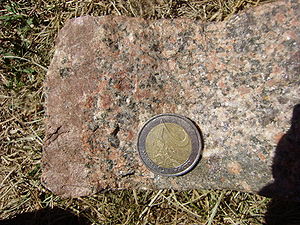
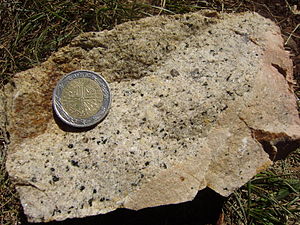
The granodiorite massif is interspersed with numerous gray, often pink, microgranitic aplite dikes . The corridors can be up to several kilometers long and up to 1 meter, sometimes even up to 10 meters, and are mostly more or less vertical. The phenocrystals are quartz, feldspars and biotite; they usually only have small grain sizes, but can reach 10 millimeters in the feldspars. The alkali feldspar is also part of the base of the aplit courses. The corridors are mostly north-south oriented with a typically crossed corridor network consisting of the directions N 020 and N 160.
Associated with the pink aplites is a coarser-grained red facies , which occurs in two larger bodies at Ballerand and at Fargeas (municipality of Abjat-sur-Bandiat ). It carries micropegmatites and pegmatitic geodes. It also contains occasional inclusions of quartz diorite and monzogabbro .
The red color of the aplit ducts and the red facies is due to an intensive hematitization of the plagioclase. The rocks were consequently exposed to Fe metasomatosis (see adjacent thin section). The biotites are strongly chloritized, which suggests a transformation under retrograde conditions.
Pegmatites
Also pegmatites occur occasionally, usually in the form of courses, often also called drusen with beautiful smoky quartz in the formed cavities.
Lamprophyre
Lamprophyre veins are not uncommon in the metamorphic neighboring rocks of the granodiorite massif, but they are extremely rare in the granodiorite itself. When freshly chipped, the lamprophyres are dark gray-greenish, very dense, fine-grained rocks that weather beige. They have the lowest SiO 2 content of all types of facies and are very close to the dioritic pole (quartz-bearing microdiorites, related to tonalites ).
| Oxide wt.% |
Micro-granite | Aplit facies | Lamprophyre | CIPW norm percent |
Micro-granite | Aplit | Lamprophyre |
|---|---|---|---|---|---|---|---|
| SiO 2 | 63.70 | 72.00 | 60.00 | Q | 18.30 | 32.92 | 14.45 |
| TiO 2 | 0.56 | 0.28 | 0.79 | Or | 15.98 | 27.71 | 13.30 |
| Al 2 O 3 | 15.74 | 14.20 | 15.10 | From | 28.83 | 27.06 | 21.51 |
| Fe 2 O 3 | 1.04 | 0.45 | 0.90 | On | 20.25 | 4.39 | 28.84 |
| FeO | 3.60 | 1.30 | 4.63 | Tuesday | 0.14 | 0.45 | |
| MnO | 0.08 | 0.04 | 0.10 | Hy | 13.29 | 3.60 | 16.95 |
| MgO | 3.55 | 0.88 | 5.04 | Mt | 1.87 | 0.84 | 2.52 |
| CaO | 4.21 | 0.90 | 4.25 | Il | 1.07 | 0.55 | 1.56 |
| Na 2 O | 3.36 | 3.20 | 3.44 | Ap | 0.26 | 0.28 | 0.42 |
| K 2 O | 2.67 | 4.60 | 2.17 | C. | 2.65 | ||
| P 2 O 5 | 0.12 | 0.12 | 0.17 | ||||
| H 2 O - | 0.05 | 0.08 | 0.16 | ||||
| H 2 O + | 0.87 | 1.10 | 1.85 | ||||
| Mg # | 0.63 | 0.54 | 0.65 | ||||
| A '/ F | 0.02 | 0.63 | −0.01 | ||||
| Al / K + Na + Ca | 0.98 | 1.19 | 0.96 |
The aplit facies are clearly peraluminous and of the S-type , they have strong similarities to the fine-grained marginal facies. Micro-granite and lamprophyre are very similar to one another and clearly of the I-type ; They are hypaluminous to normal aluminos and obviously represent an independent type of magma or magma secretion.
tectonics
The most important tectonic fact is an omnipresent foliation in the granodiorite massif. This can usually be seen with the naked eye, especially in areas that have been weathered on the surface. This means that the massif was kinematically deformed further along with its neighboring rocks in the course of the Variscan orogeny. The opposite stereographic image reveals a clear spatial organization in the granodiorite. A cross-over pattern from the north-east-south-west and the south-east-north-west direction clearly appears - characteristic of this section in the Massif Central. The pattern can be interpreted as follows:
- a relatively flat, almost symmetrical wave structure in the southeast-northwest direction, the angle of incidence does not exceed 30 degrees - with a wavelength in the deca and hectometer range. Field observations can shear bands from the 'C' type ( Abschiebungkrenulation ) recognize.
- an asymmetrical wave structure in a north-east-south-west direction, the north-east sides of which can sometimes be very steep. C-type shear ligaments .
This means that the granodiorite massif was embedded in a supra-regional shear or Riedel zone with general material removal with expansion (drainage) to the south-east with simultaneous material transport under compression to the south-west.
With the gradual cooling of the Variscan basement, the ductile deformation also came to an end. Accumulated tensions were later reduced in the Granodiorite massif in the form of brittle faults , fractures and fissures. Aplite , pegmatite and lamprophyre penetrated the late orogenic fracture zones . Towards the end of the carboniferous period, hydrothermal solutions formed ore veins with lead - zinc - silver , but also less often arsenic - molybdenum mineralization.
Age
The age-related position of the two granitoids cannot be determined on the basis of field observations. Radiometric measurements seem to suggest a higher age of the Piégut-Pluviers granodiorite, with values of 325 + 14 and 314 ± 14 million years. The Saint Mathieu leuco granite has been dated 315 ± 17 and 304 ± 17 million years ago. The high standard deviation in these Rb-Sr values , however, warns you to be careful. Measured values with the more reliable U-Pb method are missing so far. The purely petrological typology of the Piégut-Pluviers-Granodiorite also indicates its older age.
Final consideration
According to its modal inventory , ie the classification according to the main minerals in the QAPF diagram , the rock of the massif is still referred to as granodiorite, but is in the immediate vicinity of the granite field. From a chemical point of view, however, it is already a granite, more precisely an adamellite ; in the TAS diagram, for example, it falls into the rhyolite field R.
On the surface, the granodiorite massif appears to be quite homogeneous. But on closer inspection, numerous facies can be distinguished. Chemical analyzes indicate the existence of rock types with significantly lower levels of SiO 2 (fine-grained edge facies containing hornblende, micro-granite processes, lamprophyre and dark inclusions). The clear demarcation of the microdiorite and lamprophyr facies from the rest of the rock facies in the rock parameters suggests the presence or hybridization of two magma types .
In addition to purely magmatic structures such as streaks and regulation of the feldspars (viscous flow texture) but are also clearly tectonic structures can be seen in Granodioritmassiv: foliation , shear zones with SC structure and Abscherungskrenulation or ECC structure ( . English extensional crenulation cleavage or abbreviated ecc ). Mylonitized rocks can also be found on the southern edge of the massif .
The occasional occurrence of myrmecite and the hematitis of the plagioclase are indications of metasomatic processes. The chloritization of the biotite points to a retrograde, green slate facial overprinting of the granodiorite massif. This retromorphism can be found in large parts of the Massif Central.
The massif thus emerged from a complex interplay of magmatic, metasomatic and ultimately tectonic processes.
Economic benefit
The granodiorite was once economically used in a wide variety of ways. Due to its mineralization along the marginal fault, the metals lead, zinc and subordinate silver were mined on the Cantonnier Dike and in its vicinity. Otherwise it was used as stone or processed into quarry stone, gravel and crushed stone for the construction industry or road construction. Today there is only one working quarry near Abjat-sur-Bandiat , where the rare and decorative red facies are still being mined. All other quarries, such as the Tabataud quarry in Nontron, the quarry in Piégut or the quarry in Lacaujamet, which previously supplied large stones, have now been closed. You can still see numerous former scraps that were approached for local road construction.
The granodiorite massif as a repository
In connection with the search for a suitable repository for the radioactive waste from the French nuclear power plants , ANDRA considered several granite massifs at the end of the 1990s, including the Piégut-Pluviers granodiorite. However, this project subsequently met with great resistance from the local population (several large demonstrations, including in Piégut-Pluviers), so that the Piégut site was finally moved away. In addition to further research into granitoids (e.g. in the massif of Civray - Charroux , Department Vienne, hidden under Jurassic sediments ) in the Seuil du Poitou , ANDRA is now obviously focusing on the repository in Bure in the Department of Meuse ( clay sediments ).
Photo gallery
swell
- Editions BRGM: Carte géologique de la France au millionième 6 ème édition . Service Géologique National, 1996, ISBN 2-7159-2128-4 .
- Éditions BRGM: Geological maps of the BRGM on a scale of 1/50000. Leaves Châlus , Nontron, La Rochefoucauld , Montbron and Thiviers .
- Passchier, CW and Trouw, RAJ: Microtectonics . Springer Verlag, 1998, ISBN 3-540-58713-6 .
Individual evidence
- ↑ Christian Le Carlier de Veslud include: Relationships between granitoid and mineral deposits: three-dimensional modeling of the Variscan Limousin Province (NW French Massif Central) . In: Transactions of the Royal Society of Edinburgh: Earth Sciences . tape 91 , 2000, pp. 283-301 , doi : 10.1017 / S0263593300007446 .



